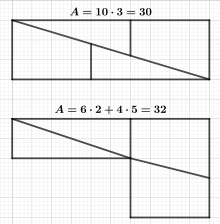Hooper's paradox
Jump to navigation
Jump to search
English[edit]

Etymology[edit]
Published in 1774 by William Hooper.
Proper noun[edit]
- A falsidical paradox based on an optical illusion, where a geometric shape with an area of 32 units is dissected into four parts, which are then assembled into a rectangle with an area of only 30 units; however, the triangles of the dissected shape are not quite identical to the triangles in the rectangle.
